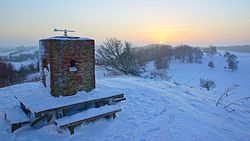Agri Bavnehøj
| Agri Bavnehøj, hill Barrow Mound, Denmark | |
|---|---|

Agri Bavnehøj is one of 4 barrow mounds and vista points in National Park Mols Bjerge
|
|
|
Agri Bavnehøj is located on the peninsula, Djursland in Denmark, by to the entrance to The Baltic Sea between Denmark and Sweden.
|
|
| Location | Syddjurs Municipality |
| Nearest city | Ebeltoft |
| Coordinates | 56°13′48.30″N 10°32′12.10″E / 56.2300833°N 10.5366944°ECoordinates: 56°13′48.30″N 10°32′12.10″E / 56.2300833°N 10.5366944°E |
Agri Bavnehøj (or Agri Bavnehoej) is a Danish hill and vista point with a bronze age burial mound 137 meters above sea level close the village, Agri, in Mols Bjerge National Park on the southern part of the peninsula, Djursland, 40 kilometers north east of Denmark’s second largest city, Århus. The mound was built 1800 – 1000 years BC. Agri Bavnehøj is the least known of 4 vista points and burial mounds on southern Djursland, even though it’s the highest (by a few meters) The others are Stabelhøje, Trehøje and Ellemandsbjerg.
From the mound there is a view over Århus Bay, Jutland, Southern Djursland, Ebeltoft Bay, the Kattegat Sea and central parts of Mols Bjerge National Park. On a clear day one can also see across The Kattegat Sea to the island Zealand, where the Danish capital Copenhagen lies. Agri Bavnehøj is less than a kilometer east of another vista point, Stabelhøje, 135 meters above sea level, where the view is perhaps even better. The feeling of height is emphasized by the view being all the way down to sea level. The Agri Bavnehøj hill was formed by ice sheet movements 12.000 years ago in connection with the last ice age.
The old Danish word, bavn, in Bavnehøj, means stack of wood or fire placed on high ground. The bronze age people and their ancestors used Agri Bavnehøj and other hilltop barrows as part of a warning system, where one lit fires on hilltops to warn neighbor communities of dangers, such as invasions. The neighbors in return lit fires on their own designated hilltops, creating a telegraph chain of fires, spreading the word of unrest. This function was maintained all the way up to the 18-hundreds - actually as late as in the Three Year War (Treårskrigen) 1848 -50, that amongst other things saw the withdrawal of the Danish general Olaf Rye’s army past Århus over southern Djursland to the peninsula Helgenæs that he fortified at the narrow Dragsmur passage 8 kilometers from Agri Bavnehøj. From Helgenæs Rye succeeded in shipping the army to Fredericia in the southern part of Jutland in Denmark, where the army was able to continue fighting, after having maneuvered around the German front by sailing round it.
...
Wikipedia

